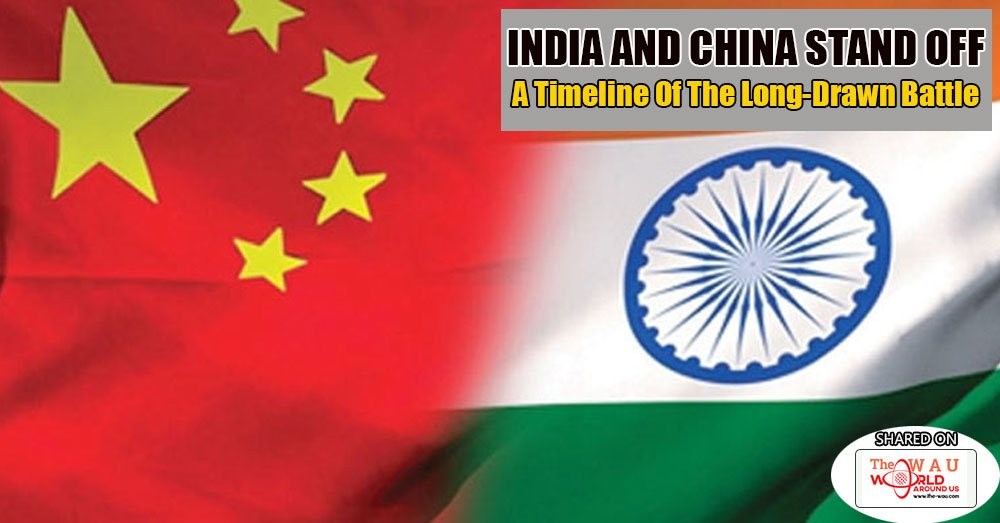Entering the eighth week of the Doklam crisis, India and China are both seemingly reinforcing their troops. China is standing strong on their demand that India pulls back its defense forces completely, however, India has softened its terms by demanding that China pulls back the construction equipment rather than the Chinese troops before India withdraws its own army.
Indian force has been deployed at the Doklam front on Bhutan’s demand to safeguard its national sovereignty. As a response, the Chinese have suspended the Kailash-Mansoravar Yatra through the Nathu La pass, and in addition they have warned India not to forget its historical defeat in the 1962 war.
To better understand this historical reference made amid the heated Indo-China Doklam standoff, it’s important to understand a timeline of the historical events which have led to this rising turbulence.
The Association
It all started in 1949 when India became the second non-communist nation to recognize the Peoples’ Republic of China after the proclamation on October 1st, followed by K M Panikker to be appointed the first Ambassador to China on 1st April 1950. Later in October 1950, the Chinese troops crossed the boundary of Sino-Tibetan region to move towards Lhasa. In May 1951, the Tibetan Governor of Chamdo was forced to concede full suzerainty over Tibet by China.
The start of all issues
India raised objection in 1955 about an infringement of Panchsheel stating that portions of India’s norther frontier were included in the map of China. In January 1959, Zhou Enlai declared China’s claims over 40,000 square miles of Indian territories in Ladakh and NEFA. To add to the rising tension, on 3rd April 1959, Dalai Lama escaped from Lhama and crossed over to Indian territory, and India decided to not only welcome him but to offer the land as a safe haven. This greatly upset Beijing intensifying an issue that still persists.
Furthermore, situations tensed up on 8th September 1959, when China rejected McMohan Line with Zhou Enlai saying the 1842 Peace Treaty between British India and England was not signed with China’s consent and made claims to 50,000 square miles of Indian territories in Sikkim and Bhutan.
In 1960, a meeting was held in New Delhi, where discussions between Zhou Enlai and Nehru about the boundary crisis ended in a deadlock. By 1961 China had further occupied 12,000 square miles of western sector along the Sino-Indian border.
The War
In 1962, China unleashed an attack in November on the eastern front invading Tawang, demolishing Walong in the western sector, and bombing Rezang La and the Chushul airport. The Chinese troops went ahead to capture Bomdila in the NEFA region as well. On 21st November China declared a ceasefire and withdrew its troops back by 20km behind the LAC.
It had become clear that India seemed like a threat to China’s rule of Tibet, which is what led to the entire dispute and the war. Various military and political conflicts between India and China unraveled in 1962. On July 10, 1962, India’s post Chushul was surrounded by 350 Chinese troops and also declared warnings to the Gurkhas over loudspeakers to not fight for India. Until the war had started, India was still preparing for the possibility and was almost surprised when the first attack had begun. India had only deployed two divisions of troops whereas the Chinese troops were better prepared with three regiments positioned in the tension zone. Indians defended heartily and managed to control the damages, however the Chinese won and seemed satisfied that the war had achieved China's policy objectives to secure borders in the western sector.
India suffered great losses due to lack of preparation with the standoff between 10,000-20,000 Indian troops and 80,000 Chinese troops. The war went on for a month and only ended after China declared ceasefire on November 21.
The Aftermath
In 1969, India initiated a peaceful offer to work with China with mutual respect for the sovereignty and territorial integrity of each nation, and also resolved to not interfere in internal affairs.
The latest report from May 2017 is that India has declined the Chinese invitation to take part in the Belt and Road Initiative summit in Beijing, and has clearly stated objections regarding the initiative.
India wasn’t ready for war, but China had attacked anyway. Attacked on October 20, 1962 India became a part of this long drawn political war with China since then. The Chinese have recently warned India to remember the 1962 war and maybe learn from it. Well, India should be taking notes and stay prepared for any possibility of war.
Share This Post















